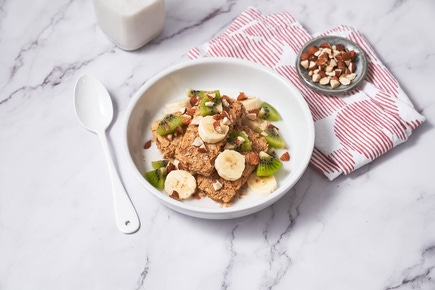
There are 5 kinds of breakfast eaters: which one are you?
Forget about reading tea leaves. Australian researchers have been pondering cereal bowls and toast crumbs to uncover more about us.
It seems breakfast choices can give away how old you are, your gender, how much you earn and even whether you’re married.
The research, conducted by Deakin University's Institute for Physical Activity and Nutrition (IPAN), and funded by the National Heart Foundation, looked at records of what people ate, drawing on data from the 2011-2012 National Nutrition and Physical Activity Survey.
Head researcher Dr Rebecca Leech hopes the findings can be used to help people make healthier food choices.
“Breakfast is often a meal we have out of habit. By doing this type of analysis, we can see where people can make some simple, practical, and hopefully sustainable switches that will improve the nutritional quality of different breakfast types, and also which areas of the population need more support to make those changes,” says Dr Leech.
Dr Leech explains the five breakfast personalities and the easy switches to make mornings healthier:
Dr Leech’s tip – This group is off to a great start. Choosing wholegrain cereals and breads, instead of refined varieties, to eat at breakfast could help people meet their daily fibre requirements and reduce their risk of certain health conditions including diabetes, bowel cancer and heart disease.
While this group was healthiest, only one in three men and two in five women had fruit with their cereal. I’d recommend adding fruit like banana or berries, together with some plain yoghurt or nuts, to improve the fibre, protein, vitamins and minerals in their bowls.
Dr Leech’s tip – Cereal choice matters. Try replacing a low fibre breakfast cereal with a wholemeal or wholegrain varieties to increase fibre and phytonutrient content. Add some banana, berries, seeds or nuts to plain cereals. Or even grab a piece of fruit or a handful of nuts and seeds if you’re short on time and running out the door.
Dr Leech’s tip – Swap processed meats like bacon for a nutritious plant protein like baked beans. Most people don’t eat enough vegetables so ensure that your protein food is accompanied by a side of veggies such as mushrooms, tomato, or baby spinach. And don’t forget to swap white breads for grainy, wholegrain and wholemeal varieties to boost your fibre and nutrient intake.
Dr Leech’s tip – Like with cereals, it’s best to stick with the wholegrains, choosing grainy, wholemeal or wholegrain breads. Consider adding baked beans or an egg to boost protein and nutrient intakes and promote healthy ageing. Introduce some healthy plant-based fats such as a nut spread like peanut butter, sesame seed spread such as tahini or seasonal avocado.
Dr Leech’s Tip – Swap white bread with a wholemeal or wholegrain variety to increase fibre and phytonutrient content. Also consider what you drink with breakfast and swap out sugary drinks for water or herbal tea.
The Deakin University research was funded by the National Heart Foundation and National Health and Medical Research Council. The funders and Sanitarium had no involvement in the study. Views expressed in this article are those of Dr Leech and do not reflect the views of the NHMRC.
It seems breakfast choices can give away how old you are, your gender, how much you earn and even whether you’re married.
The research, conducted by Deakin University's Institute for Physical Activity and Nutrition (IPAN), and funded by the National Heart Foundation, looked at records of what people ate, drawing on data from the 2011-2012 National Nutrition and Physical Activity Survey.
Head researcher Dr Rebecca Leech hopes the findings can be used to help people make healthier food choices.
“Breakfast is often a meal we have out of habit. By doing this type of analysis, we can see where people can make some simple, practical, and hopefully sustainable switches that will improve the nutritional quality of different breakfast types, and also which areas of the population need more support to make those changes,” says Dr Leech.
Dr Leech explains the five breakfast personalities and the easy switches to make mornings healthier:
1. Wholegrain cereal and milk
People eating this breakfast type, which was sometimes topped with dried fruit, nuts and seeds and possibly fresh fruit and yoghurt, were more likely to be older and married. The men were more likely to have a higher education and higher income. Regular wholegrain cereal eaters were more likely to be non-smokers, physically active and have a healthier weight than other types of breakfast eaters.Dr Leech’s tip – This group is off to a great start. Choosing wholegrain cereals and breads, instead of refined varieties, to eat at breakfast could help people meet their daily fibre requirements and reduce their risk of certain health conditions including diabetes, bowel cancer and heart disease.
While this group was healthiest, only one in three men and two in five women had fruit with their cereal. I’d recommend adding fruit like banana or berries, together with some plain yoghurt or nuts, to improve the fibre, protein, vitamins and minerals in their bowls.
2. Mixed cereals and milk
This was the most common breakfast with more than 30 per cent of women and men eating mixed cereal and regularly. So how does it differ to the wholegrain cereal and milk group? This group includes a mix of cereal types (wholegrain, refined grain and sweetened cereals) with regular or reduced fat milk but no dried fruit, nuts, seeds or yoghurt.Dr Leech’s tip – Cereal choice matters. Try replacing a low fibre breakfast cereal with a wholemeal or wholegrain varieties to increase fibre and phytonutrient content. Add some banana, berries, seeds or nuts to plain cereals. Or even grab a piece of fruit or a handful of nuts and seeds if you’re short on time and running out the door.
3. Protein foods
While this type of breakfast was the only one to include vegetables, it also included eggs and/or processed meats, such as bacon or sausages, and was typically paired with low fibre refined grain bread and unsaturated spreads and oils. It was the least common breakfast choice only eaten by 11% and was generally eaten after 9am or on weekends, when we have more time. Those more likely to go for the cooked brekkie were younger women and men, as well as people from non-English speaking backgrounds.Dr Leech’s tip – Swap processed meats like bacon for a nutritious plant protein like baked beans. Most people don’t eat enough vegetables so ensure that your protein food is accompanied by a side of veggies such as mushrooms, tomato, or baby spinach. And don’t forget to swap white breads for grainy, wholegrain and wholemeal varieties to boost your fibre and nutrient intake.
4. Breads and spreads (Type 1)
Yes, toast lovers are broken down into two groups too. This group includes those eating refined or wholegrain breads together with healthy unsaturated spreads, like margarine or nut butters as well as unhealthy spreads that were high in sugar, saturated fat or salt, like jam. A lot could be told from this breakfast choice. Men who ate this type of brekkie were almost all coffee or tea drinkers and tended to be older, married, have lower incomes, live in an inner regional city and have not worked in the past week. Women in this category were more likely to choose wholegrain breads with spreads and were also older and more likely to be married.Dr Leech’s tip – Like with cereals, it’s best to stick with the wholegrains, choosing grainy, wholemeal or wholegrain breads. Consider adding baked beans or an egg to boost protein and nutrient intakes and promote healthy ageing. Introduce some healthy plant-based fats such as a nut spread like peanut butter, sesame seed spread such as tahini or seasonal avocado.
5. Breads and spreads (Type 2)
This group chose refined breads and spreads that were high in saturated fats, sugar or salt. Men were more likely to have a sugar-sweetened drink, like a fruit or soft drink or cordial, rather than coffee or tea, and were younger and more likely to have worked in the past week. The women in this category preferred refined-grain bread varieties.Dr Leech’s Tip – Swap white bread with a wholemeal or wholegrain variety to increase fibre and phytonutrient content. Also consider what you drink with breakfast and swap out sugary drinks for water or herbal tea.
The Deakin University research was funded by the National Heart Foundation and National Health and Medical Research Council. The funders and Sanitarium had no involvement in the study. Views expressed in this article are those of Dr Leech and do not reflect the views of the NHMRC.

The latest nutrition advice, plus health and wellness tips delivered to your inbox monthly

